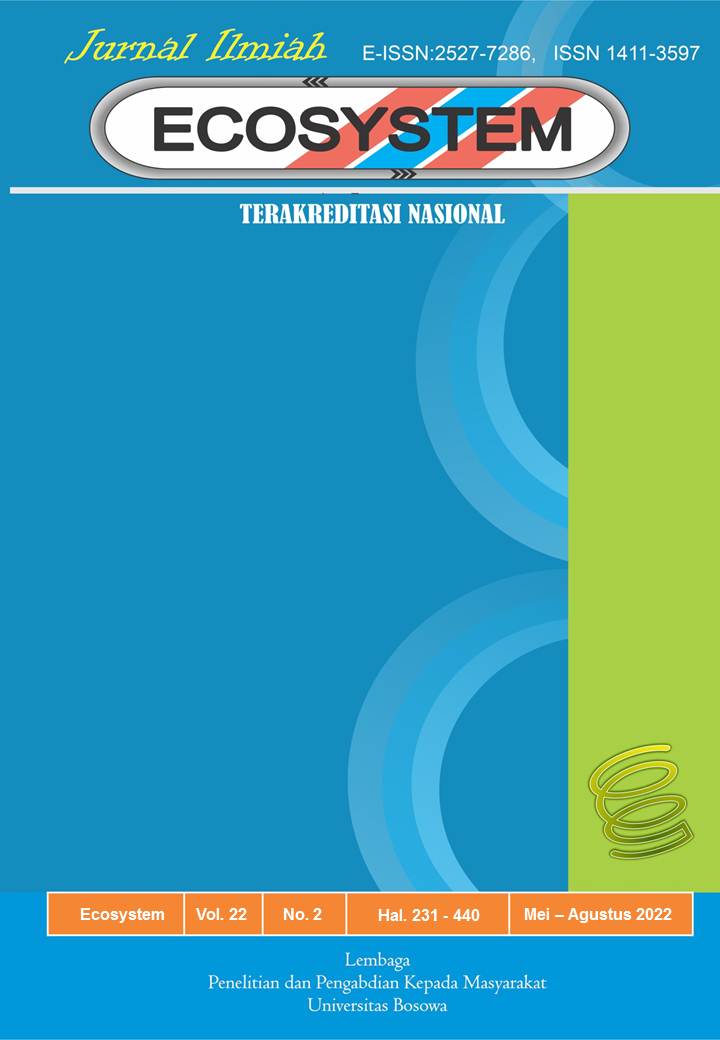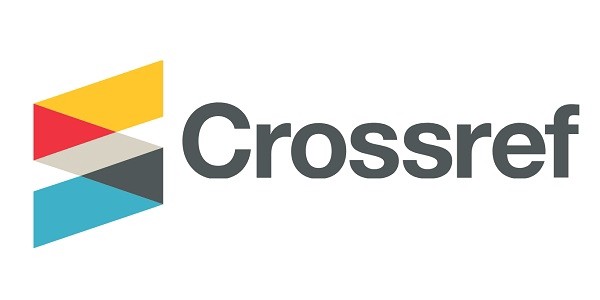Respons Pertumbuhan dan Hasil Kentang terhadap Jenis Bioetanol dan Ekstrak Daun Gamal di Dataran Medium
DOI:
https://doi.org/10.35965/eco.v22i2.1635Keywords:
Bioetanol, Ekstrak Daun Gamal, Kualitas KentangAbstract
Budidaya kentang selama ini dikembangkan di dataran tinggi (>1000 m Dpl), karena kentang berproduksi tinggi jika ditanam pada dataran tinggi dengan suhu 17-20 ºC. Namun, di dataran tinggi terkendala masalah terbatasnya areal dan biaya produksi tinggi. Penelitian ini dilaksanakan pada bulan April sampai Juli 2022 di desa loka, Balai Benih Hortikultura, Kecamatan Ulu Ere, Kabupaten Bantaeng sebagai sentra pengembangan kentang di Sulawesi Selatan. Penelitian ini bertujuan untuk menganalisis pengaruh jenis bioetanol dan konsentrasi ekstrak daun gamal terhadap pertumbuhan dan hasil kentang, serta interaksi antara jenis bioetanol dengan konsentrasi ekstrak daun gamal terhadap pertumbuhan dan hasil kentang. Penelitian dilakukan dalam bentuk percobaan yang disusun menggunakan Rancangan Petak Terpisah (RPT). Petak utama adalah penggunaan Ekstrak Daun Gamal dan tanpa perlakuan dengan ekstrak daun gamal. Ekstrak daun gamal yang terdiri dari 3 taraf perlakuan yaitu 0 ml/l air, 200 ml/ l air, and 400 ml/ l air. Anak petak adalah penggunaan bioetanol dengan 4 taraf yaitu, tanpa perlakuan bioetanol, bioetanol dari eceng gondok, bioetanol dari kulit singkong, dan bioetanol dari kulit kentang. Hasil percobaan menunjukkan bahwa penggunaan bioetanol yater baik adalah bioetanol dari kulit kentang. Ekstrak daun gamal 400 ml/l air menghasilkan pengaruh yang terbaik terhadap pertumbuhan dan hasil kentang.
Potato cultivation has been developed in the highlands (>1000 m above sea level), because potatoes produce high yields if grown in the highlands with a temperature of 17-20 0C. However, in the highlands, there are problems with limited area and high production costs. This research was conducted from April to July 2022 at the Horticulture Seed Centre in the Ulu Ere subdistrict, Bantaeng Regency, South Sulawesi. The study aims to analyze the effect of the type of bioethanol and the concentration of gliricidia sepium extract on the growth and yield of potatoes, as well as the interaction between the type of bioethanol and the concentration of gliricidia sepium extract on the growth and yield of potatoes. The study was conducted in the form of an experiment arranged using a split plot design (SPD). The main plot is the use of gliricidia sepium extract and without treatment with gliricidia sepium extract. Gliricidia sepium extract consisted of 3 treatment levels, namely 0 ml/l water, 200 ml/l water, and 400 ml/l water. The sub-plots used bioethanol with 4 levels, namely, without treatment with bioethanol, bioethanol from water hyacinth, bioethanol from cassava peels,, and bioethanol from potato skins. The experimental results show that the best use of bioethanol is bioethanol from potato skins. gliricidia sepium extract 400 ml/l water gave the best effect on potato growth and yield.
Downloads
References
Acquaah, G. 2007. Principles of Plant Genetics and Breeding. Blackwell Publishing. Malden Oxford-Victoria. 569.
Akharaiyi, F.C and B. Boboye. 2012. Antimicrobial and Phytochemical Evaluation of Three Medicinal Plant. J. Nat. Prod., 3:27-35.
Akinnifesi, F.K., W. Makumba, G. Sileshi, O.C. Ajayi and D. Mweta, 2007. Synergistic Effect of Inorganic N and P Fertilizers and Organic Inputs from Gliricidia sepium on Productivity of Intercropped Maize in Southern Malawi: Plant Soil., 294: 203-217.
Badan Pusat Statistik dan Direktorat Jendral Hortikultura. 2018. Produksi Kentang Menurut Provinsi tahun 2015- 2017. Kementrian Pertanian Republik Indonesia
Demirci, A. and G. Izmirlioglu. 2015. Enhanced Bio-ethanol Production from Industrial Potato Waste by Statistical Medium Optimization, International. Journal of. Moleculer Sciences. 16: 244490-24505.
Guo, M., J. Littlewood, J. Joyce and R. Murphy, 2014. The Environmental Profile of Bioethanol Produced from Current and Potential Future Poplar Feed Stocks in the EU. Green Chem, 16(11): 4680-4695.
Littlewood,J.,M. Guo, W. Boerjan, R.J. Murphy, 2014. Bioethanol from Poplar: a Commercially Viable Alternative to Fossil Fuel in the EU. Biotechnol Biofuels,7:113-120
Mariska, I.,E.G. dan D. Lestari, Sukmadjaja, dan D. Suardi. 2004. Seleksi In vitro dan Identifikasi Tanaman Padi Varietas Gajah Mungkur, Towuti, dan IR 64 yang Tahan Kekeringan. Kumpulan Makalah Seminar Hasil Penelitian BB-Biogen, hal.170–179.
McGiffen, M. E dan J. A. Manthey. 1996. The Role of Methanol Promoting Plant Growth: A Current Evaluation. Hort. Science. 31 (7): 1092-1096.
Muhibuddin, 2016. Inovasi Teknologi Pengembangan Budidaya Kentang di Dataran Medium. CV Sah Media. Teori dan Pengalamn Empiris. Makassar. 197 hlm
Muhibuddin, A. Z. Razak, A.Halik and J. Boling. 2015. Growth and Production of Two Varieties of Potatoes in Plains Medium with Methanol Supplements. International journal of current research and academic review 3(5) 330-340.
Muhibuddin,A., Z.Razak, S. Salam, and J. Boling, 2016. Development of Potato Plants as the Results of Aeroponic Technology by Treating of Methanol in Plain Medium at Ulu Ere Sub District, Bantaeng Regency, South Sulawesi, Indonesia. International Journal of Current Research and Academic Review, 4(9): 140-348.
Nomomura, A. M dan A. A Benson 1992. The Path of Carbon in Photosynthesis. Improved Crop Yield with Metanol. Proc. Natl. Acad. Sci. USA. 89:8794-8798.
Novianti, N., Umar, N. A., & Budi, S. (2022). Pengaruh Berbagai Konsentrasi Anggur Laut Caulerfa lentillirea Pada Pakan Terhadap Pertumbuhan Ikan Nila . Journal of Aquaculture and Environment, 4(2), 45–49.
Rukmana, R. 1997. Kentang budidaya dan pasca panen. Kanisius, Yogyakarta
Setiadi, 2009. Budidaya Kentang. Penebar Swadaya. Jakarta. 156 hlm
Simons, A. J. 1996. Ecology and Reproductive Biology. Tropical Forestry Papers. Oxford Forestry Institute, Oxford.
Soelarso, B. 1997 Budidaya Kentang Bebas Penyakit.Penerbit Kanisius, Yogyakarta Penelitian Untuk Pengembangan Petani Kecil. Jakarta: UI-Press.
Stark, J. C. and S. L. Love. 2003. Potato Production System. University of Idaho Agricultural Communication. Idaho, U.S.A.
Togashi, N., A. Shiraishi, M. Nishizaka, K. Matsuoka, Endo and K. Hamashima. 2007. Antibacterial Activity of Long-Chain Fatty Alcohols Against Staphylococcus aureus, Molecules, 12:139-148.
Tovar, P., R. Chandra., R. Ruiz de Arcaute dan J. H. Dodds. 2007. Effect of Médium Composition on In vitro tuberization. Am. Potato J. 64: 462.
Zakaria, B. 2010. Stimulan CO2 terhadap Fotosintesis dan Cekaman Tanaman. Penerbit Kretakupa Print, Makassar.
Downloads
Published
Issue
Section
License
Copyright (c) 2022 Zulkifli Maulana, Andi Muhibuddin, Fatmawati Fatmawati, Haris Mahmud

This work is licensed under a Creative Commons Attribution 4.0 International License.












